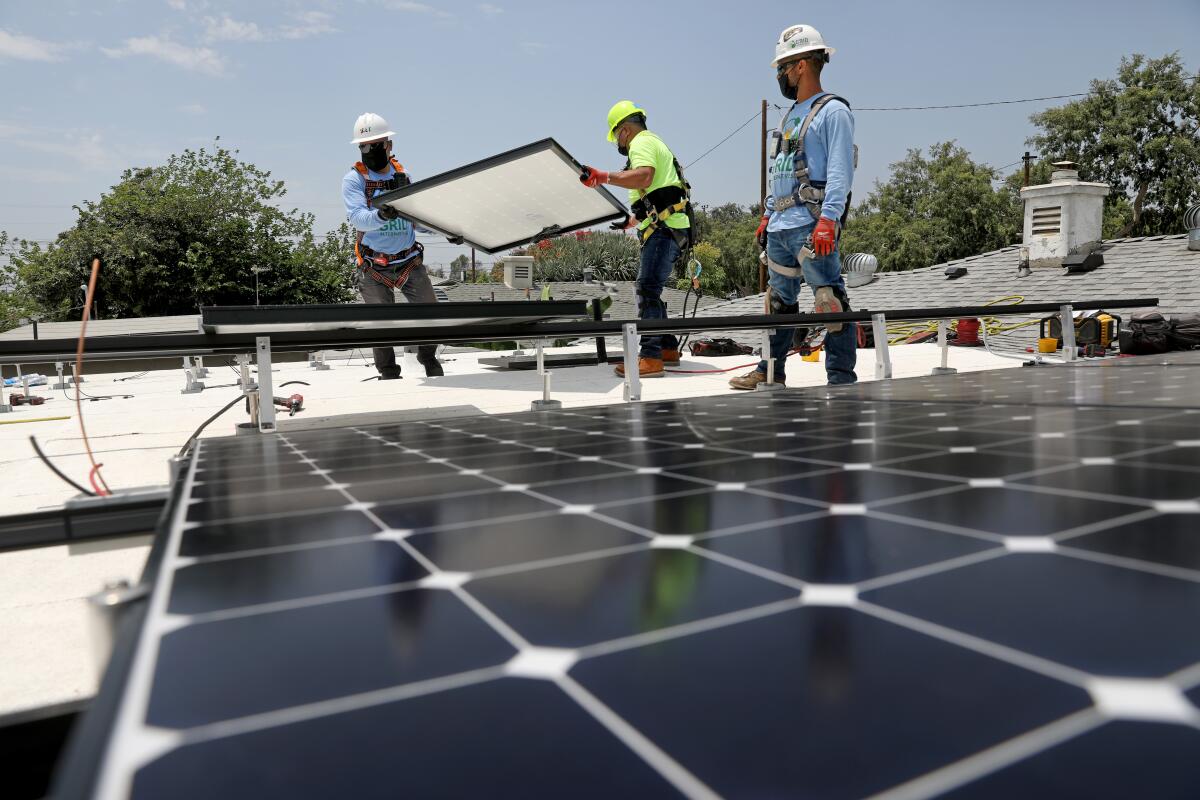Editorial: California can’t enact a ‘solar tax’ and still be a climate leader

- Share via
Of all the details in California regulators’ plan to slash incentives for installing rooftop solar systems, the most confounding is the idea of charging customers a hefty monthly fee to go solar.
The state Public Utilities Commission plan, released in December, includes a “grid participation charge” of $8-per-kilowatt of installed solar, which amounts to more than $50 a month in additional fees for a typical residential customer.
The PUC’s sweeping proposal would also dramatically cut the compensation solar customers receive for the electricity they provide to the grid through a key incentive program, called net energy metering, that is largely responsible for establishing California as the nation’s largest rooftop solar market, with more than 1.3 million systems installed. The plan is an attempt to reduce what utilities and regulators say is an unfair distribution of costs that is driving up electricity rates and putting a disproportionate burden on low-income customers.
But this proposal tips the scales squarely in favor of utility companies, primarily Southern California Edison, Pacific Gas & Electric and San Diego Gas & Electric, which profit from massive solar farms and transmission lines, while disadvantaging everyday people seeking to generate solar energy in their own communities. These changes would make the economics of installing rooftop panels far less attractive by dramatically increasing the time it would take for customers to make back their investments. A recent analysis by energy research firm Wood Mackenzie found that the state regulators’ proposal would cut California’s solar market in half by 2024.
Newsom’s one-time budget-surplus funding plan for climate change is a good thing. But it’s no substitute for real climate action by state lawmakers.
It makes sense to scale back incentives over time as the market matures and as prices fall. But regulators should not move forward with something so drastic that it could derail one of California’s most successful clean energy programs, at a time when we need leaders to be using every tool at their disposal to hasten emissions reductions. Doing so wouldn’t only be bad for the climate, it threatens to exacerbate inequality just as solar is starting to be adopted by increasing numbers of low-income Californians, who are all too often excluded from the benefits of clean energy.
The good news is that state regulators seem to be rethinking their initial approach.
Gov. Gavin Newsom told reporters last month that the plan needs work. He recently appointed two new commissioners to the PUC, including its president, Alice Reynolds, who was previously his senior energy advisor. The net metering proposal was pulled from a scheduled meeting last month and was paused indefinitely Thursday after being assigned to Reynolds, who has requested more time to consider revisions.
Commissioners must understand that they cannot fix this flawed plan with small tweaks that give the illusion of a reasonable compromise. They must significantly dial it back and abandon the idea of a new monthly fee.
This decision has been at the center of highly charged and polarizing fight. On one side are the state’s three big monopoly utility companies, organized labor and consumer advocates and others who argue that solar customers are being compensated too generously and not paying their fair share of the costs of maintaining the power grid. They say younger, lower-income people and renters who can’t afford or are unable to install solar are shouldering the burden in the form of higher rates, and that solar electricity can be produced far more cheaply by large-scale solar farms.
On the other side are solar installation companies, whose labor force is largely nonunion, and many climate and environmental activists, who want solar to keep growing in a decentralized way and largely dismiss concerns about the unequal distribution of costs.
Southern California air quality has worsened partly because of port emissions. Yet city officials show no urgency to protect people from the pollution.
Since December, high-profile figures have weighed in against the plan, including GOP former Gov. Arnold Schwarzenegger — who decried it as a “solar tax” — and Democratic Sen. Dianne Feinstein. Opponents are rightly concerned about the practical implications of cutting incentives that have fueled the growth in rooftop solar, not to mention the message it would send to gut a cornerstone of California’s growing renewable energy economy. There is at least some agreement among experts that the fixed monthly charge is a ham-handed way to address inequities in electricity costs.
While it’s encouraging that the PUC’s December proposal includes fee exemptions and higher compensation for low-income Californians who install solar systems, as a whole it does not do enough to ensure that solar power does not, once again, become something only the wealthy can afford.
California needs to keep building solar capacity and battery storage to supplant use of natural gas and other fossil fuels and reach its climate targets. At the same time, California already has some of the nation’s highest electricity rates, and those costs and their distribution need to be addressed, especially as we move to electrify home appliances, heating and vehicles in the coming years.
But state officials must find a way forward that does not make it so much harder for people to go solar. Newsom and his appointees can use their power to devise a better proposal that ensures growing numbers of Californians can afford to install panels and be a part of the transition to renewable energy.
More to Read
A cure for the common opinion
Get thought-provoking perspectives with our weekly newsletter.
You may occasionally receive promotional content from the Los Angeles Times.












